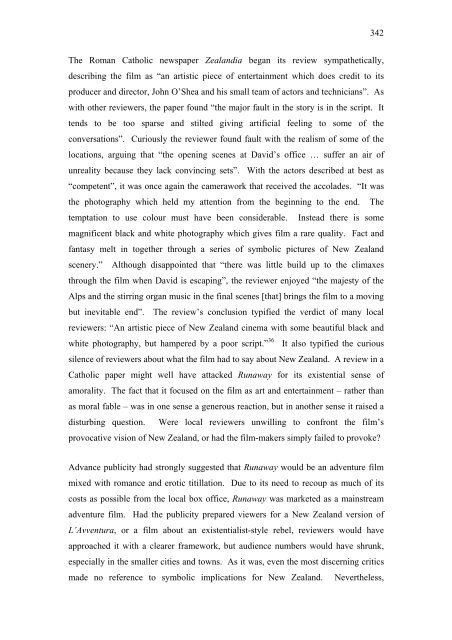Copyright Statement - ResearchSpace@Auckland
Copyright Statement - ResearchSpace@Auckland
Copyright Statement - ResearchSpace@Auckland
Create successful ePaper yourself
Turn your PDF publications into a flip-book with our unique Google optimized e-Paper software.
342<br />
The Roman Catholic newspaper Zealandia began its review sympathetically,<br />
describing the film as “an artistic piece of entertainment which does credit to its<br />
producer and director, John O’Shea and his small team of actors and technicians”. As<br />
with other reviewers, the paper found “the major fault in the story is in the script. It<br />
tends to be too sparse and stilted giving artificial feeling to some of the<br />
conversations”. Curiously the reviewer found fault with the realism of some of the<br />
locations, arguing that “the opening scenes at David’s office … suffer an air of<br />
unreality because they lack convincing sets”. With the actors described at best as<br />
“competent”, it was once again the camerawork that received the accolades. “It was<br />
the photography which held my attention from the beginning to the end. The<br />
temptation to use colour must have been considerable. Instead there is some<br />
magnificent black and white photography which gives film a rare quality. Fact and<br />
fantasy melt in together through a series of symbolic pictures of New Zealand<br />
scenery.” Although disappointed that “there was little build up to the climaxes<br />
through the film when David is escaping”, the reviewer enjoyed “the majesty of the<br />
Alps and the stirring organ music in the final scenes [that] brings the film to a moving<br />
but inevitable end”. The review’s conclusion typified the verdict of many local<br />
reviewers: “An artistic piece of New Zealand cinema with some beautiful black and<br />
white photography, but hampered by a poor script.” 36 It also typified the curious<br />
silence of reviewers about what the film had to say about New Zealand. A review in a<br />
Catholic paper might well have attacked Runaway for its existential sense of<br />
amorality. The fact that it focused on the film as art and entertainment – rather than<br />
as moral fable – was in one sense a generous reaction, but in another sense it raised a<br />
disturbing question. Were local reviewers unwilling to confront the film’s<br />
provocative vision of New Zealand, or had the film-makers simply failed to provoke?<br />
Advance publicity had strongly suggested that Runaway would be an adventure film<br />
mixed with romance and erotic titillation. Due to its need to recoup as much of its<br />
costs as possible from the local box office, Runaway was marketed as a mainstream<br />
adventure film. Had the publicity prepared viewers for a New Zealand version of<br />
L’Avventura, or a film about an existentialist-style rebel, reviewers would have<br />
approached it with a clearer framework, but audience numbers would have shrunk,<br />
especially in the smaller cities and towns. As it was, even the most discerning critics<br />
made no reference to symbolic implications for New Zealand. Nevertheless,















